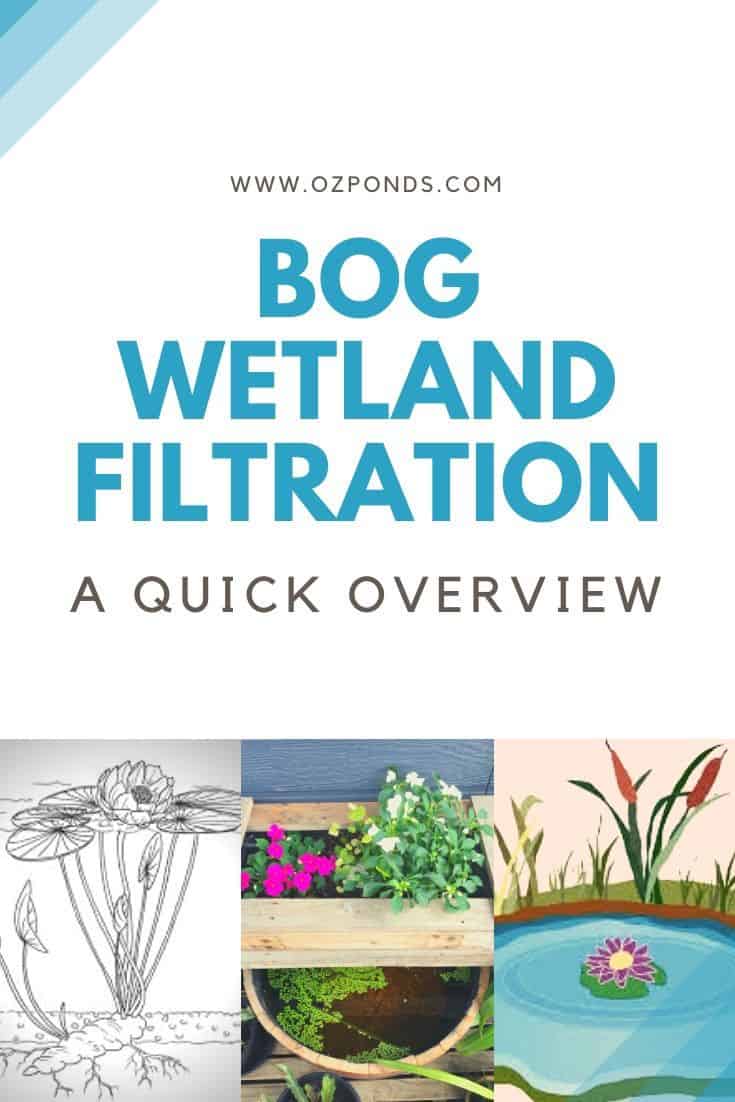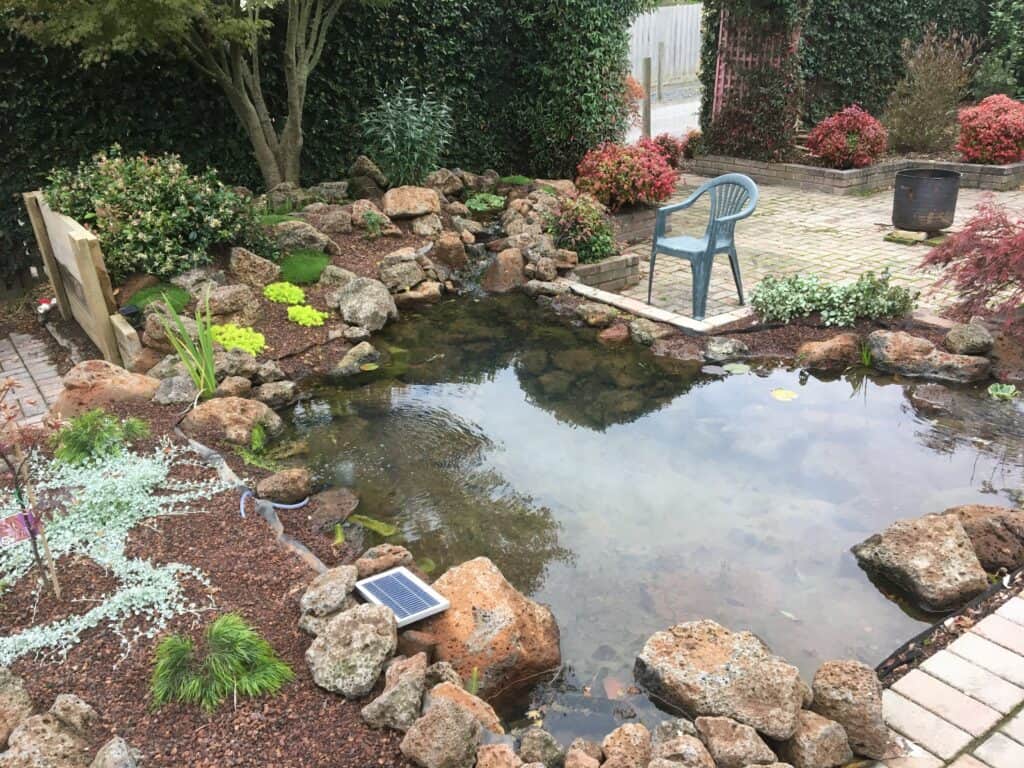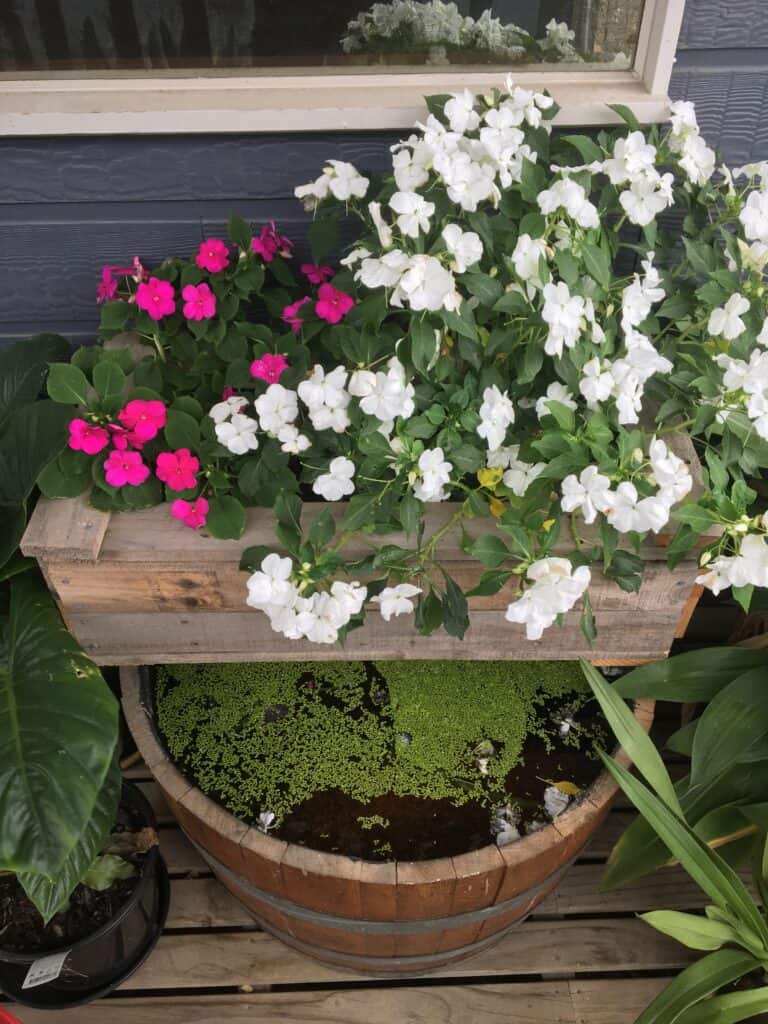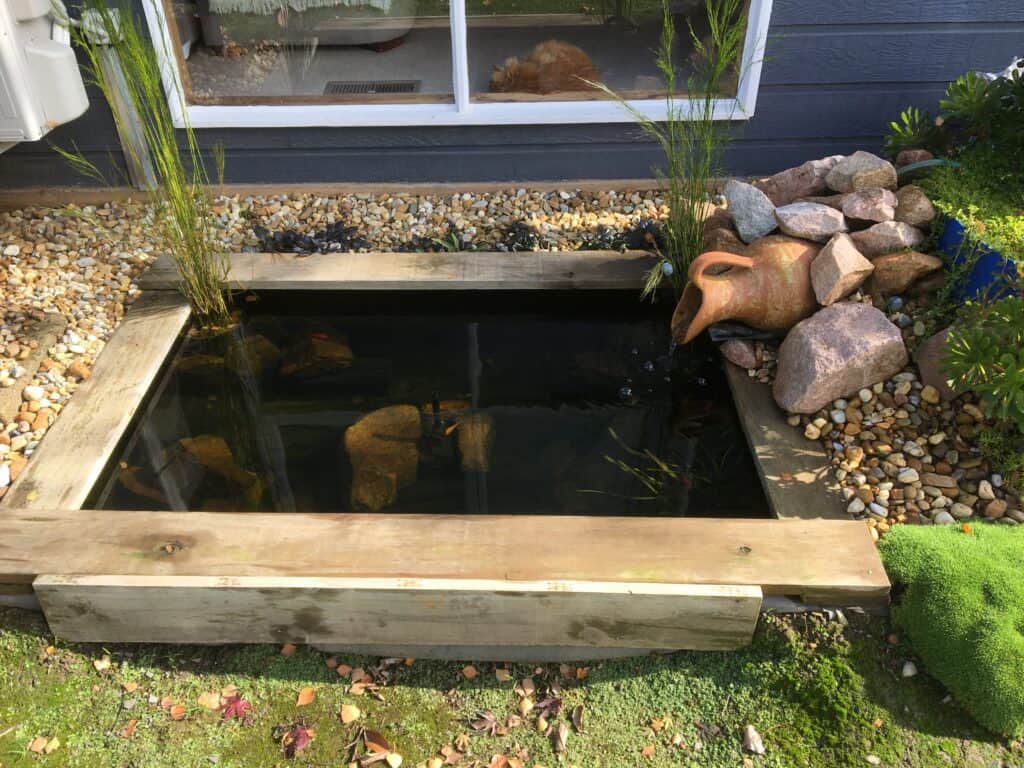Wetland or Bog filters are hands down the best pond filtration system there is!
Whatever sized pond you are creating it’s easy to add a wetland or bog filter.
There are so many different ways that a bog or wetland can be incorporated into your pond. From small patio fish ponds, swim ponds and even large commercial ponds!
These filters blend into the pond environment so easily and can even become a feature in themselves.
Maintenance on a bog or wetland filter is minimal! Because it works in complete harmony with nature.
All we are doing is creating the perfect environment.
Let me tell you how they work and why they are so damn awesome!
How natural wetlands and bogs work
In nature wetlands and bogs are natural purifiers of water. They do this by slowing down the water and allowing it to be purified by bacteria and plants.
The amount of water a bog or wetland can filter is astonishing!
- 1 acre of healthy wetland is able to purify 27,633,506 Litres of polluted dirty water!
- A healthy wetland can remove 96% of all nitrogen in the water!
- A healthy wetland can remove 97% of the phosphorus within the water.
Wetlands are one of the most ecologically diverse habitats on the planet. Unfortunately they have quite often been destroyed as they were seen as ugly and smelly!
We are finally starting to understand just how valuable wetlands and bogs truly are.
As i mentioned they purify the water, they slow the water allowing it to seep into the surrounding soil (this helps during times of drought), they store carbon, they process nutrients, they help prevent erosion and they provide a habitat to countless plants, animals and insects!
It’s no wonder as you’ve no doubt seen large estates are now constructing wetlands. These are being used to purify storm runoff before it goes into the natural waterways.
Wetlands are being constructed on mining sites to strip harmful metals from the water before it makes its way into our steams and rivers.
I come from a wholesale plant nursery background and many large nurseries are starting to use constructed wetlands to recycle their nutrient rich water.
Some councils are even starting to use constructed wetlands to process waste water.
As you can see wetlands are truly remarkable and incorporating them into our pond designs will give us clearer/ healthier water.
How wetlands and bogs work in a pond
In a pond their main function is providing perfect habitat for beneficial bacteria, removing solids (such as fish poo) and stripping the water of nutrients (predominantly nitrate).
Beneficial bacteria is incredibly important to water health and quality. If you don’t know about the nitrogen cycle and the role it plays in water health read this article.
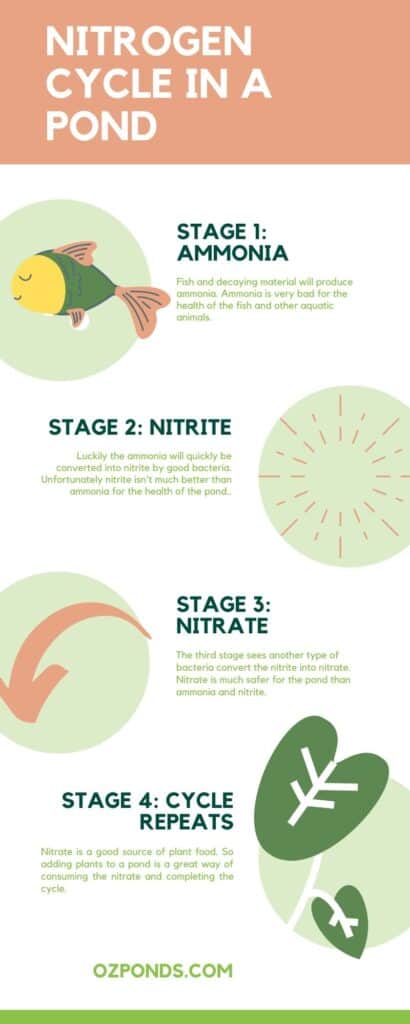
Basically what happens is the bacteria breaks down harmful ammonia and nitrite into less harmful nitrate. The beneficial bacteria that perform this function need plenty of wet surfaces to grow on.
Rocks and plant roots are a perfect surface for the bacteria to grow on. Using rock in your bog or wetland filter provides this.
The water should move slowly through the rocks so the bacteria has adequate time to work it’s magic.
As mentioned the bacteria will create nitrate as a byproduct. This is the main function of the plants within the wetland or bog.
The plants will consume the nitrate. This allows beautiful clean water to return to the pond. Removing nitrate from the water will greatly reduce algae within the pond.
The plants will also break down some of the solids that will accumulate in the wetland / bog.
Allowing the pump to remove solids and deposit them into the wetland will improve overall water quality and water clarity.
Things to consider when building a wetland / bog filter.
- Slow the water
- Use different sized rocks
- Allow an area for solids to accumulate
The first thing we need to do is slow the water flow. This allows the bacteria and plants properly filter the water.
To do this we simply spread the flow over a larger area. The easiest way to achieve this is to run the pipe from the pump into a larger pipe with holes spread out along the length.
What this does is spreads the water evenly throughout the wetland/ bog. It then will percolate more slowly up through all the rocks and plant roots, allowing more time in contact with the bacteria.
Use different sized rocks in the filter. Start with larger rocks on the bottom and gradually change to smaller rocks on the top.
If the filter is just a small setup it’s ok to use all the same size as the wetland or bog is most likely quite shallow.
But for deeper larger bogs allowing mored space (air gaps) at the bottom will help oxygenate the water and avoid dead zones. We want to have water flowing evenly throughout the entire filter system.
Keep the bottom of the wetland free of rocks & plant roots
We want to keep the very bottom of the wetland/ bog clear of any rocks and plant roots. Just water here!
That will allow the solids an area to accumulate and make the small amount of maintenance that much easier.
This can be achieved with different products that are available. There is some pretty cool equipment specially designed for wetland/ bog filters.
Creating your own solids accumulation chamber isn’t all that difficult with some large pvc piping. Drill holes throughout the piping to create even flow.
Making this chamber area easy to access is important so that we can remove the solids from the filter.
This is almost the only maintenance thats required.
For large wetlands/bogs you’ll want to get a sump pump down there. Smaller systems a siphon hose will work.
Maintenance
So speaking of maintenance, there really isn’t much to do apart from removing any solids that accumulate within the filter.
If we don’t remove them, there is the potential that they will clog up the wetland/bog and make it less effective.
There is a few ways this can be done. On a small bog filter (patio ponds, small fish ponds) this can be as simple siphon, or installing a valve or tap that will allow the filter to be backwashed.
Because the bog is always full with water, when you open the valve or tap the water will rush out. The idea is that the majority of solids within the bog will sink to the bottom and come out of the tap.
This nutrient rich water is great for the veggies!
For larger bogs and wetlands adding a drain can sometimes be difficult. So generally it’s a good idea to create an inspection port of sorts.
This can be a large pipe that goes down through the rocks and gravel to the water column where the solids will mostly accumulate.
Using a pipe large enough to fit a sump pump will allow you to remove all the accumulated solids rather easily.
Another idea i have is using a siphon drain. This would work by installing a pipe through the rocks and gravel and having a valve on the end.
Once the valve is opened it would initiate a siphon and thus suck out the solids also. At least in theory. Of course if you got a blockage you’re in for quite a lot of work.
A third option would be installing the drain down low where the solids actually accumulate. But this would involve putting a hole through the liner. And I never like doing that.
Removing the solids is the most important maintenance to do. There is no timetable definitive timetable i can give you on how often this needs to be done. Every pond is different and the amount of fish will vary.
What i personally like to do is give the wetland/ bog a flush at the start of each new season.
If you’ve designed it well that should just be the opening of a tap and letting the solids flow. Or sticking in a sump pump. Too easy 🙂
General gardening
The only other task to do in the wetland/bog filter is just general gardening.
This can be as hands on or hands off as you choose.
Some people like to keep their ponds more formal and structured while others like natural and unruly.
Whichever you are it never hurts to do a little removal of any dead or dying foliage.
Some designs principles for bog/wetland filters
Wetlands and bogs are incredibly robust and versatile systems. They are also very forgiving!
The design doesn’t need to be perfect!
By providing the breeding grounds for beneficial bacteria and utilising the plants to strip away nutrients, your wetland will find its balance and provide great water quality.
- The most important thing is to slow the water velocity, allowing the water to percolate over as much surface area as possible.
- And being able to remove the solids.
Accomplish those 2 things and you’ll have a thriving bog or wetland.
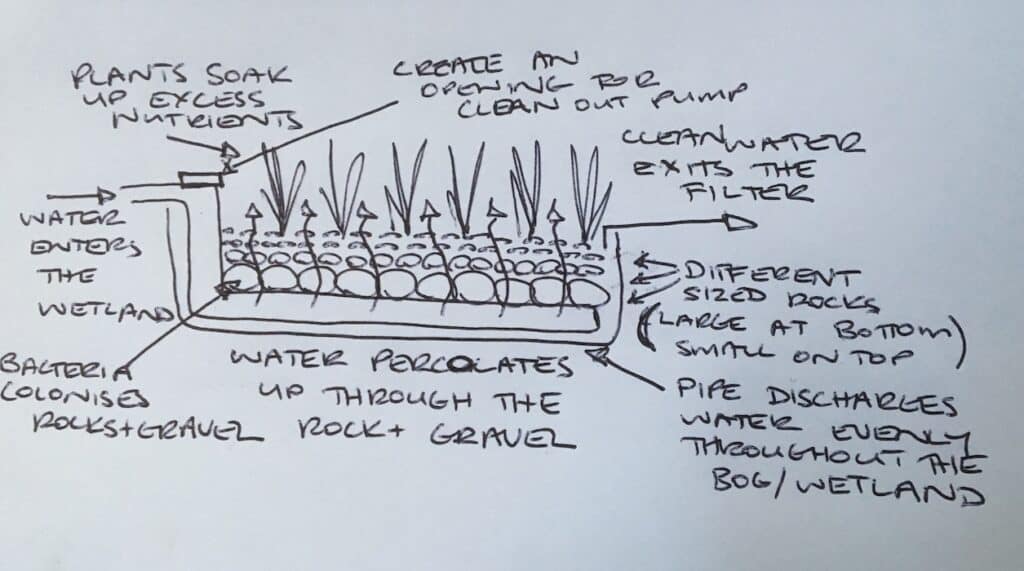
Plants to use in your pond bog/ wetland filter
You can basically use any aquatic or bog plant you please.
I avoid using overly aggressive plants as i worry about them clogging the system or even worse puncturing the liner.
Also vigorous plants require more maintenance and i want to enjoy my water gardens not be a slave to them.
Try and mix up the varieties. Keep in mind that the pond will produce nutrients all year long so you’ll want to include evergreen varieties as well as well as deciduous species.
Spring is often a time of excess nutrients so having those deciduous species that fire up and start activily growing during this time of year is greatly beneficial.
FAQ
Why are my plants not growing?
This is because the bacteria and micro-organisms within your wetland/ bog filter are doing such an excellent job that their just simply isn’t enough nutrients for the plants to grow.
Give yourself a pat on the back. If you would like to increase the nutrients available for the plants you could add more fish to your pond.
Wont the wetland/ bog be a breeding ground for mosquitos?
Absolutely not!
The water is still flowing through the wetland/ bog filter. Mosquitos hate moving water and will not colonise your wetland/bog filter.
If you have a question?
Use the contact us form to submit your question. I’ll do my very best to answer it swiftly.
Subscribe
I often receive special offers and discounts from pond suppliers and distributors. These special offers i share with the readers.
If you would like to receive these special offers and discounts make sure you subscribe to the mailing list, so i can deliver them direct to your inbox.

